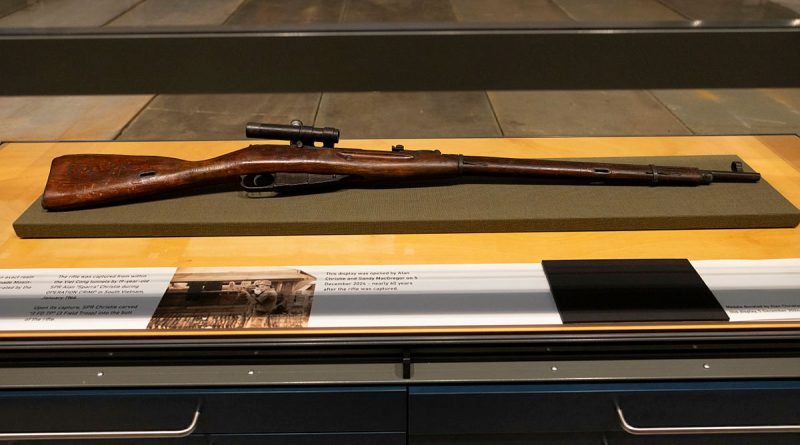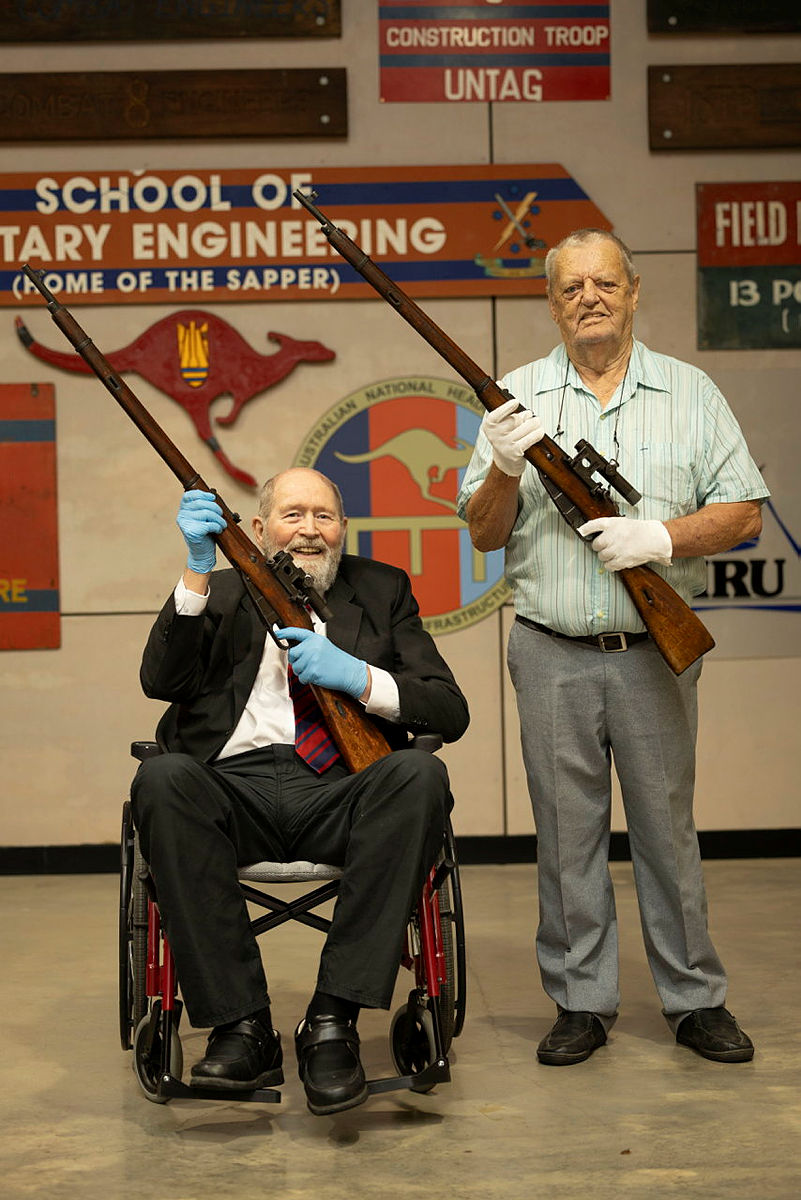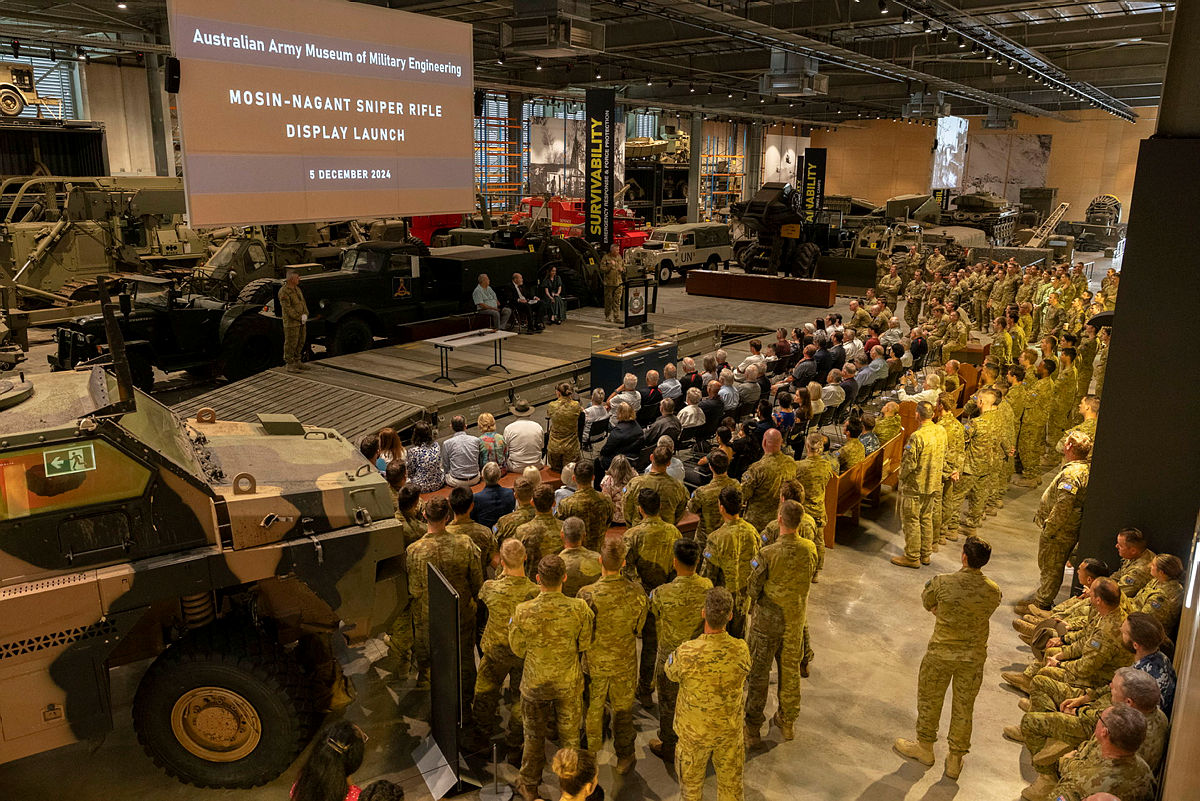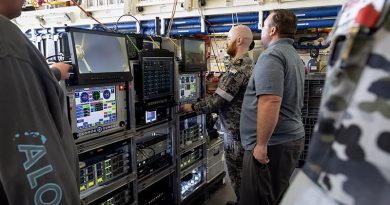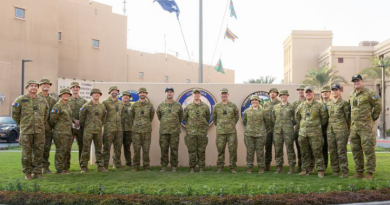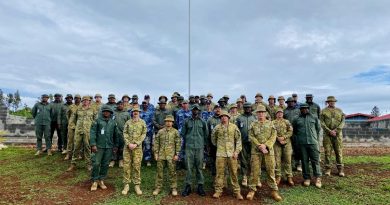Tale of a sniper rifle has double-barrelled ending
Share the post "Tale of a sniper rifle has double-barrelled ending"

Two Australian soldiers were killed and two wounded by sniper fire in the rice fields of Vietnam in January 1966.
CAPTION: The replica Russian Mosin-Nagant sniper rifle on display during its unveiling at the Australian Army Museum of Military Engineering in Holsworthy. Story and photos by Sergeant Matthew Bickerton.
During the contact, an injured but determined enemy sniper left a 200-metre blood trail as he crawled to reach an underground tunnel.
Borrowing an Owen Gun with its stock removed from a medic, Sapper (retd) Alan Christie from 3 Field Troop volunteered to pursue and followed in complete darkness.
“I could hear him ahead of me and assumed he could hear me,” Mr Christie said.
He pressed on, encountering vegetation contaminated with phosphorus deliberately left every few metres by the sniper to hinder his pursuit.
Moving forward another 40 or 50 metres, Mr Christie came across the sniper’s rifle in a “beautiful” leather case.
“I could see he was losing a lot of blood and would soon bleed out,” he said.
After 15 minutes of pursuit and no longer hearing the sniper’s retreat, Mr Christie took the rifle and turned back, mindful that venturing further might force another sapper to come after him.
“I returned to the surface and to make sure the engineers retained the rifle, I vandalised it by carving 3 Field Troop (3 FD TP) on the butt with my bayonet,” he said.
This took place during the joint US-Australian Operation Crimp.
The 1st Battalion, the Royal Australian Regiment (1RAR), along with their attached sappers, were tasked with acting as a blocking force while two other battalions in the brigade would push the enemy towards them.
CAPTION: Australian Army Vietnam War veterans Colonel (retd) Sandy MacGregor, left, and Sapper (retd) Alan Christie pose with the captured Russian Mosin-Nagant sniper rifle from Operation Crimp in 1966 and its replica.
The 3 Field Troop commander, Captain Sandy MacGregor, now Colonel (retd), said that’s not what happened, but instead 1RAR encountered the tunnels immediately.
“When the infantry couldn’t find where the bullets came from, they called on the engineers,” Colonel MacGregor said.
What they discovered became known as the Cu Chi tunnels – an underground network from which the enemy fired through concealed holes, covering an area where 1RAR had initially planned to land but changed course at the last moment.
“First, we blew tear gas into the tunnels to get the enemy out,” Colonel MacGregor said.
They followed with smoke grenades to expose other entrances to the tunnel complex, but the effort revealed little.
Before sending more sappers down, there was an attempt to blow the smoke and tear gas out of the tunnels.
“Our blokes went in with tear gas masks to search but started passing out. The smoke didn’t clear after blowing air down the tunnels. There was not enough oxygen,” Colonel MacGregor said.
He explained that when someone passed out, another person would have to retrieve them.
“The tunnels were so tight, you couldn’t get someone on the other side. They had to be dragged out, and it was bloody awful,” Colonel MacGregor said.
Most of this searching took place on the days after Mr Christie retrieved and claimed the sniper rifle for the engineers.
However, the infantry took possession of the rifle and have since stored it in the armoury at Singleton, NSW.
The captured Russian Mosin-Nagant sniper rifle is the only one of its kind in Army.
Colonel MacGregor spent decades unsuccessfully petitioning for its release to the Royal Australian Engineers.
Recently, there was a compromise.
To honour the history of the ‘Tunnel Rats’, the Australian Army History Unit borrowed the rifle and commissioned a replica.
The replica was crafted at Gaza Ridge Barracks in Bandiana, where the model maker spent hours outside the armoury, meticulously casting resin and perfecting every detail.
The unveiling was held at the Australian Army Museum of Military Engineering (AAMME), Holsworthy, on December 5, 2024, attended by Colonel MacGregor, Mr Christie and more than 200 civilians, veterans and Army personnel, with the replica and the original rifle on display.
It had been 58 years since Colonel MacGregor and Mr Christie last saw the rifle.
The replica is on permanent display inside the AAMME, while the original was returned to Singleton.
CAPTION: More than 200 civilians, veterans and Army personnel gather at the unveiling of the replica Russian Mosin-Nagant sniper rifle.
.
.

.
.
Share the post "Tale of a sniper rifle has double-barrelled ending"

